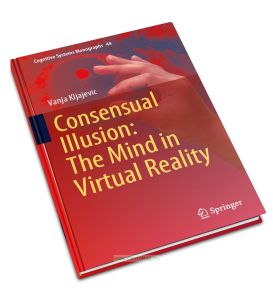- Артикул:00-01093157
- Автор: Vanja Kljajevic
- ISBN: 978-3-662-63740-1
- Обложка: Твердая обложка
- Издательство: Springer (все книги издательства)
- Страниц: 140
- Год: 2021
- Вес: 507 г
- Серия: Cognitive Systems Monographs (все книги серии)
Consensual Illusion. The Mind in Virtual Reality/Иллюзия согласия. Разум в виртуальной реальности
Книга на английском языке
The notion that virtual reality is not experienced as another, radically different type of reality, but as an extension of what is already there as physically real, is based on the assumption that there is a reality-virtuality continuum, with the two being positioned at the far ends of the continuum and separated by mixed reality (Milgram et al. 1995). Unlike physically real environments, which by definition remain free of computer-generated interventions, virtual reality environments are on the opposite end of the continuum, being completely computer-generated. Along the continuum we find mixed environments, more specifically augmented reality, in which most of the images are images of real objects, and augmented virtuality, in which most of the images are computer-generated. This concept of display technologies is based on the notion that presence, interactivity and reproduction fidelity are key factors that determine where on the continuum lays a specific application1
Contents
1 A New Kind of Extension
1.1 From Real to Virtually Real
1.2 Extensions
1.3 Being …Where?
1.3.1 Breaks in Presence
1.3.2 Cognitive Penetrability of Visual Perception and Presence
1.3.3 Some Other Factors Affecting Presence
1.3.4 Lost and Inverse
1.4 Physicality Expectations and Pathways to Illusion
1.4.1 Virtual Embodiment
1.4.2 FeelingWhat is not There
1.5 Consensual Illusion
References
2 Self in Virtual Reality
2.1 The Puzzle of Having a Self
2.2 Disjoint Self
2.2.1 TheMinimal Self
2.3 Denaturalized Body
2.3.1 Body Representation: Body Image and Body Schema
2.3.2 A Combined Tools Extension of the Body
2.3.3 Bodily Self-Consciousness
2.3.4 Spatial Perspective Taking and Extracorporeal Experiences
2.3.5 Perceptual Asynchrony and Information Integration
2.4 The Neural Basis of Self-Representation
References
3 Self and the Virtual Other
3.1 Social Cognition
3.1.1 Theory of Mind
3.1.2 Attributing Minds to Non-Human Entities
3.1.3 TheWe-Mode
3.1.4 Relational Models
3.2 The Social Brain
3.3 Social Interaction in Virtual Environments
3.3.1 Relational Models and We-Mode in Virtual Environments
3.3.2 Interacting with Virtual Characters
3.3.3 Virtual Togetherness
References
4 Virtual Embodiment and Action
4.1 Distinguishing Own Actions from Those of Others
4.2 Action Possibilities
4.3 Vision for Action
4.3.1 Visual Scene and the Feeling of Presence
4.4 Motor Cognition
4.4.1 Hierarchies of the Action System
4.4.2 Intentional Action
4.4.3 Action Representation
4.5 Joint Action
4.5.1 Synchronous Actions: Muscular Bonding and Beyond
4.5.2 Just a Sound
4.6 Extended Embodiment and Action
References
5 Spatial Cognition in Virtual Reality
5.1 Body and the Space Around It
5.1.1 Sense of Place
5.1.2 Processing Strategies for Real versus Virtual Spaces
5.1.3 Frames of Reference
5.2 There…Where the Self Is?
5.3 Body Boundaries and Distance Sensing
5.3.1 Virtual Proxemics
5.4 Spatial Memory and the Hippocampus
5.4.1 Spatial Working Memory in Virtual Reality
References
Index
Рекомендуем




